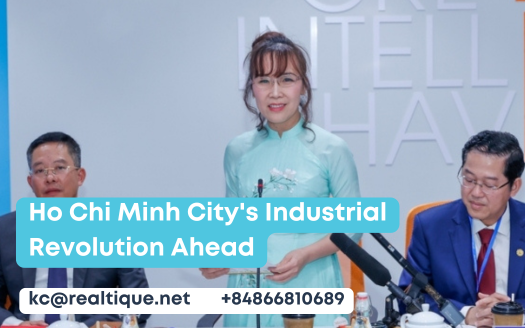Ho Chi Minh City’s Industrial Revolution Ahead
Ho Chi Minh City stands on the brink of an industrial change, with ambitious plans to cultivate a competitive and sustainable industrial ecosystem by 2030. Emphasizing green technologies and high-tech manufacturing, the city’s strategy not only aims to raise its global standing but also to create high-value employment opportunities. As significant investments in infrastructure and international partnerships unfold, the intricacies of this transition raise critical questions about its feasibility and potential impact on the local economy. What challenges must be maneuvered to guarantee this vision becomes a reality?
Table of Contents
Vision for Ho Chi Minh City's Industrial Modernization
The vision for industrial modernization in Ho Chi Minh City is a strategic blueprint aimed at converting the city’s industrial terrain into a competitive and sustainable hub by 2030.
This initiative highlights the importance of green, digital, and sustainable changes to promote a diverse industrial base.
Key objectives include enhancing global competitiveness, creating high-value jobs, and attracting skilled labor.
Additionally, the vision emphasizes a commitment to sustainable development and environmental stewardship.
By prioritizing innovation and advanced technologies, Ho Chi Minh City seeks to position itself as a regional leader in industrialization by 2045.
This change is not only crucial for economic growth but also essential for addressing environmental challenges and ensuring a resilient industrial sector for future generations.
Ho Chi Minh City's Current Industrial Landscape
Ho Chi Minh City’s industrial landscape is characterized by a substantial network of 37 industrial zones that span over 10,041 hectares, significantly contributing to the city’s GDP.
The focus of these zones is shifting towards high-tech sectors, particularly information technology and robotics, aligning with global industrial trends.
Despite their success, these industries face challenges related to competitiveness, with rising production costs and high land prices averaging $240/m².
Occupancy rates within the industrial zones are notably high, reaching 95%.
Additionally, rapid urbanization and population growth necessitate modernization efforts to meet increasing industrial demands and compete effectively within the region.
Addressing these changes is essential for sustaining the city’s industrial growth path and enhancing its economic resilience.
Numerous challenges confront industries in Ho Chi Minh City as they strive to adapt to a rapidly changing economic environment. Rising production costs and high land prices hinder competitiveness, with industrial land averaging $240/m² and occupancy rates reaching 95%.
Additionally, rapid urbanization and population growth intensify the demands on existing infrastructure, necessitating urgent modernization efforts.
Increased operational costs threaten job security for countless workers.
The struggle for survival in a competitive market leaves many businesses vulnerable.
Failure to innovate risks the city’s potential as a regional industrial hub.
Addressing these challenges is essential for the city’s industrial evolution and its vision of sustainable growth in an ever-changing global economy.
Addressing the challenges faced by industries is a prerequisite for advancing key development areas that will propel Ho Chi Minh City’s industrial evolution.
A primary focus is the promotion of green technology and renewable energy, which aligns with sustainable development goals. The city aims to expand high-tech manufacturing sectors, particularly in IT and robotics, while improving logistics and supply chain management to enhance competitiveness.
Innovation plays a crucial role, necessitating the adoption of advanced technologies to elevate productivity and minimize environmental impact. Additionally, nurturing research and development initiatives in collaboration with educational institutions will equip the workforce with essential skills.
These strategic areas will not only diversify the industrial base but also position Ho Chi Minh City as a regional industrial hub by 2030.
Investment and Infrastructure Needs
To encourage industrial growth in Ho Chi Minh City, significant investment in infrastructure is imperative. Upgrading transportation networks and developing industrial parks are vital steps to facilitate logistics and attract foreign investment.
Enhanced utilities and services will support industries, while smart city initiatives can integrate technology to streamline operations.
- Unlocking potential for job creation and economic prosperity
- Empowering local businesses to thrive in a competitive environment
- Ensuring a sustainable future for generations to come
Addressing these infrastructure needs will not only alleviate high production costs but also cultivate an environment conducive to innovation and growth, positioning Ho Chi Minh City as a leading industrial hub in the region.
Role of International Collaboration
Encouraging international collaboration is essential for Ho Chi Minh City’s industrial change and sustainable growth. By partnering with global firms, the city can utilize knowledge in advanced technologies and innovative practices, facilitating the transition to a high-tech, sustainable industrial base.
Collaborative efforts in research and development can enhance local capabilities, nurturing a culture of innovation that aligns with international standards. Additionally, foreign investment can stimulate the growth of high-tech sectors, creating job opportunities and improving the economy.
Establishing innovation hubs will further attract international talent and resources, propelling the city toward its industrial evolution goals. Ultimately, a concerted approach to international collaboration will position Ho Chi Minh City as a competitive player in the global industrial arena.
Policy Support for Innovation
International collaboration sets a strong foundation for the effective implementation of policies that support innovation in Ho Chi Minh City’s industrial sector.
The government plays a crucial part in creating an enabling environment by establishing regulatory structures that promote investment and technological advancement. By simplifying administrative processes and offering incentives for adopting green technologies, authorities can stimulate industrial growth.
- Empowering local businesses to thrive in a competitive environment.
- Fostering a culture of innovation that inspires future generations.
- Transforming the industrial environment into a guiding light of sustainability and progress.
With ongoing evaluation mechanisms, these policies can guarantee alignment with the city’s ambitious goals, ultimately clearing the path for an energetic and resilient industrial ecosystem.





